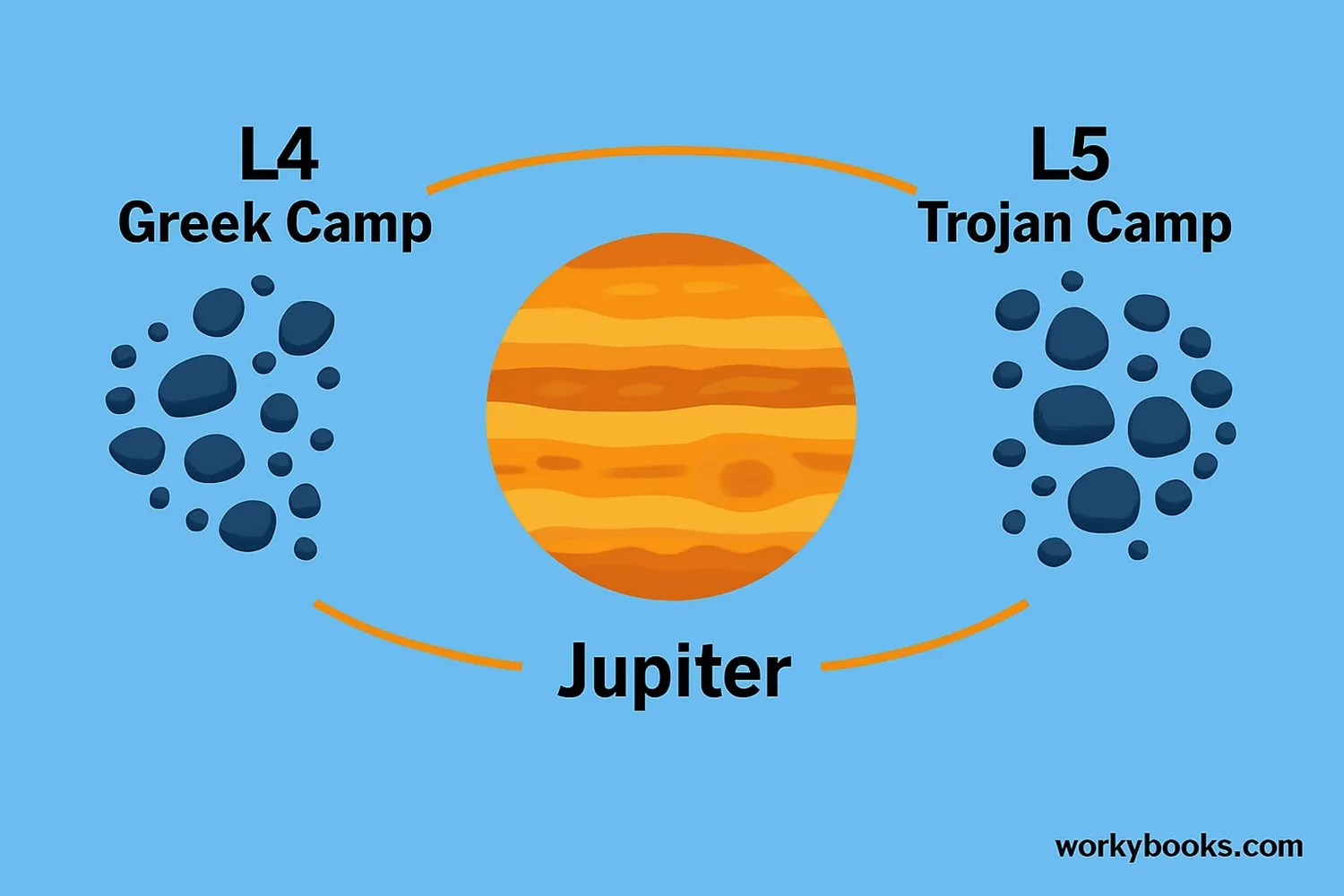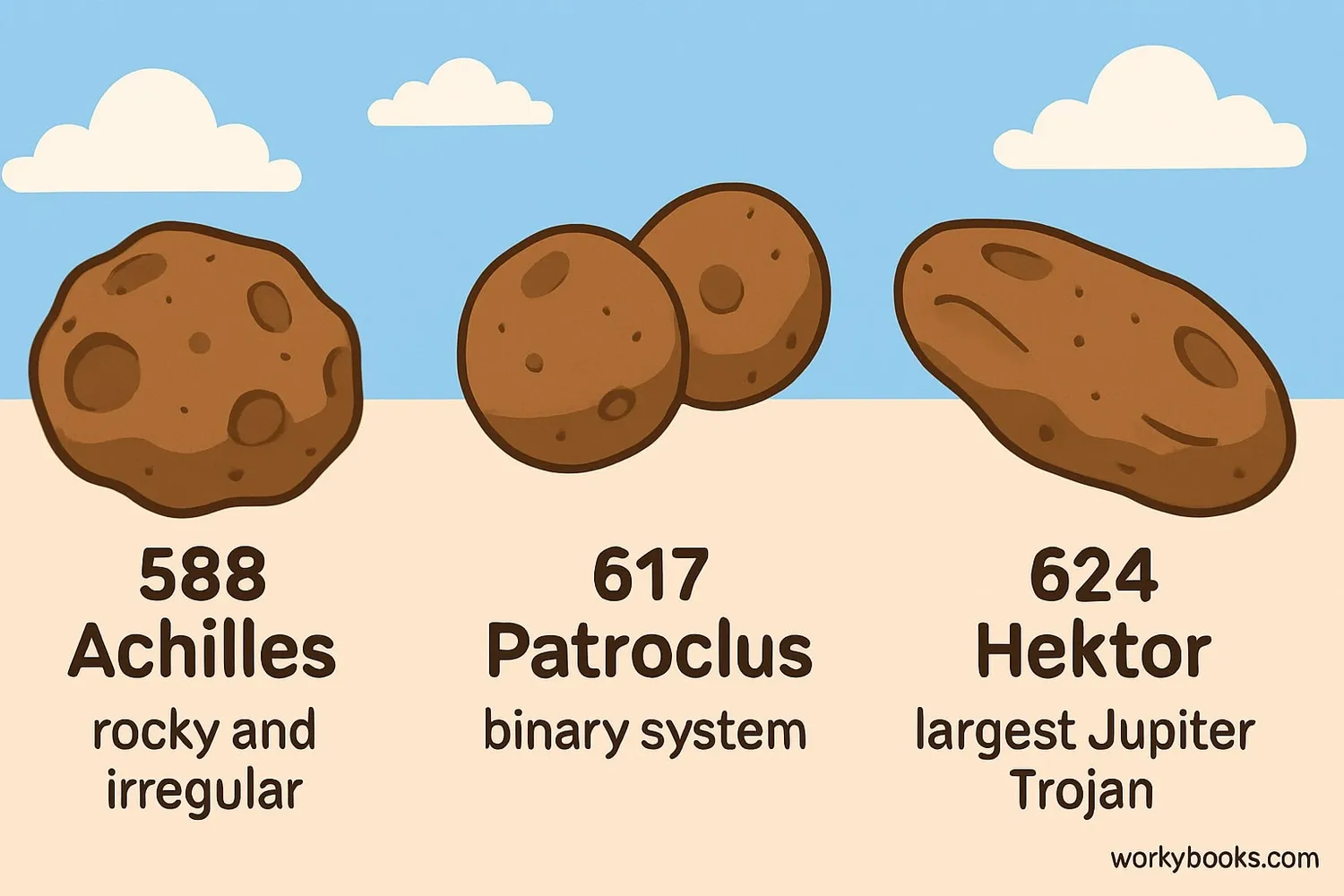Trojan Asteroids - Definition, Examples, Quiz, FAQ, Trivia
Discover the cosmic guardians that share planets' orbits
What are Trojan Asteroids?

Trojan asteroids are special space rocks that share a planet's orbit around the Sun. They don't orbit the planet like moons - instead, they travel along the same path as the planet, staying at stable points either 60 degrees ahead or 60 degrees behind the planet.
Think of it like a cosmic game of follow-the-leader! The planet leads the way around the Sun, and the Trojan asteroids stay in special "parking spots" where gravity balances perfectly.
Space Fact!
The name "Trojan" comes from the Trojan War in Greek mythology. The two groups of asteroids are named after Greek and Trojan warriors.
Lagrange Points: Gravity's Parking Spots
Trojan asteroids stay in special positions called Lagrange points (pronounced la-GRAHNJ). These are points in space where the gravity of the Sun and a planet balance perfectly with the motion of an object's orbit.
There are five Lagrange points around each planet, but only two (L4 and L5) are stable enough to hold asteroids for long periods of time:
Leading Point
60 degrees ahead of the planet in its orbit
Trailing Point
60 degrees behind the planet in its orbit
These special points act like gravity wells where asteroids can be captured and remain stable for millions of years. The L4 and L5 points form equilateral triangles with the Sun and planet, creating the perfect balance of forces.
Gravity Dance!
The Lagrange points were discovered by mathematician Joseph-Louis Lagrange in 1772, long before any Trojan asteroids were found!
Jupiter Trojans and Other Groups

Jupiter has the largest collection of Trojan asteroids! Scientists have discovered over 7,000 Jupiter Trojans, with many more expected. They're divided into two groups:
Greek Camp (L4)
Ahead of Jupiter in its orbit
Trojan Camp (L5)
Behind Jupiter in its orbit
But Jupiter isn't the only planet with Trojan companions:
• Mars Trojans: 9 known asteroids
• Neptune Trojans: 28 confirmed
• Earth Trojans: 1 confirmed (2010 TK7)
• Uranus Trojans: 2 suspected
These cosmic companions range in size from just 1 kilometer to over 200 kilometers across!
Famous Trojan Asteroids

Let's meet some of the most famous Trojan asteroids:
- 588 Achilles: The first Trojan asteroid discovered in 1906. It's in Jupiter's L4 point and is about 135 km across.
- 617 Patroclus: A binary asteroid (two asteroids orbiting each other) in Jupiter's L5 point. It was discovered in 1906.
- 624 Hektor: The largest Jupiter Trojan at 225 km long. It has a very elongated shape and even a small moon!
- 2010 TK7: Earth's first known Trojan asteroid, discovered in 2010. It's about 300 meters across.
These space rocks are like cosmic time capsules that can teach us about the early solar system. NASA's Lucy mission, launched in 2021, will visit several Jupiter Trojans to study them up close!
Trojan Asteroids Quiz
Test your space knowledge with this quiz! Answer all 5 questions to see how much you've learned.
Frequently Asked Questions
Here are answers to some common questions about Trojan asteroids:
Space Trivia
Discover some amazing facts about Trojan asteroids!
Ancient Discoveries
The first Trojan asteroid, 588 Achilles, was discovered in 1906 by German astronomer Max Wolf. He found it at Jupiter's L4 point.
Lucy Mission
NASA's Lucy spacecraft, launched in 2021, will visit 8 asteroids - 7 Trojans and 1 main belt asteroid. It will be the first mission to study Jupiter Trojans up close!
Size Matters
The largest Jupiter Trojan is 624 Hektor, which measures about 225 km (140 miles) along its longest axis. That's longer than the state of Delaware!
Earth's Companion
Earth's first confirmed Trojan asteroid, 2010 TK7, is about 300 meters across. It orbits about 80 million km ahead of Earth at the L4 Lagrange point.


